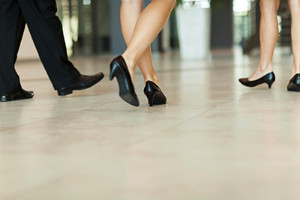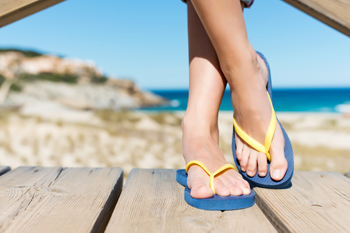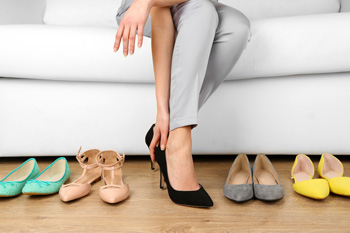Blogs
Can High Heels Damage My Feet?
 Many women choose to wear high heels to increase confidence, height, and the muscle tone of the leg. These perceived benefits may not outweigh the damage the feet may incur as a result of wearing this type of shoe. The arch of the foot is typically affected, which may lead to pain and discomfort. When the heel of the foot is raised, the ligaments of the arch become weak, and may result in the development of a condition referred to as fallen arches or flat feet. There is generally not enough room for the toes to move about freely, and this may result in a conditions such as hammertoe. The feet absorb the body’s mass, and the weight becomes redistributed, which affects the ball of the foot when high heels are worn. If high heels are frequently worn, the Achilles tendon may become shorter, causing severe pain. Recent research has suggested that wearing shoes with a shorter heel can prevent many foot injuries from occurring.
Many women choose to wear high heels to increase confidence, height, and the muscle tone of the leg. These perceived benefits may not outweigh the damage the feet may incur as a result of wearing this type of shoe. The arch of the foot is typically affected, which may lead to pain and discomfort. When the heel of the foot is raised, the ligaments of the arch become weak, and may result in the development of a condition referred to as fallen arches or flat feet. There is generally not enough room for the toes to move about freely, and this may result in a conditions such as hammertoe. The feet absorb the body’s mass, and the weight becomes redistributed, which affects the ball of the foot when high heels are worn. If high heels are frequently worn, the Achilles tendon may become shorter, causing severe pain. Recent research has suggested that wearing shoes with a shorter heel can prevent many foot injuries from occurring.
High heels have a history of causing foot and ankle problems. If you have any concerns about your feet or ankles, contact Dr. Dean D. Hinners from Illinois. Our doctor can provide the care you need to keep you pain-free and on your feet.
Effects of High Heels on the Feet
High heels are popular shoes among women because of their many styles and societal appeal. Despite this, high heels can still cause many health problems if worn too frequently.
Which Parts of My Body Will Be Affected by High Heels?
- Ankle Joints
- Achilles Tendon – May shorten and stiffen with prolonged wear
- Balls of the Feet
- Knees – Heels cause the knees to bend constantly, creating stress on them
- Back – They decrease the spine’s ability to absorb shock, which may lead to back pain. The vertebrae of the lower back may compress.
What Kinds of Foot Problems Can Develop from Wearing High Heels?
- Corns
- Calluses
- Hammertoe
- Bunions
- Morton’s Neuroma
- Plantar Fasciitis
How Can I Still Wear High Heels and Maintain Foot Health?
If you want to wear high heeled shoes, make sure that you are not wearing them every day, as this will help prevent long term physical problems. Try wearing thicker heels as opposed to stilettos to distribute weight more evenly across the feet. Always make sure you are wearing the proper shoes for the right occasion, such as sneakers for exercising. If you walk to work, try carrying your heels with you and changing into them once you arrive at work. Adding inserts to your heels can help cushion your feet and absorb shock. Full foot inserts or metatarsal pads are available.
If you have any questions please feel free to contact one of our offices located in Metropolis and Eldorado, IL . We offer the newest diagnostic and treatment technologies for all your foot and ankle needs.
Read more about Effect of High Heels on the FeetWhy Are Flip-Flops Bad for Your Feet?
 As the spring and summer months begin and bring warm weather with them, you may feel tempted to wear a pair of flip-flops. While these shoes are easy to slip on, they also make it easier to slip, leading to potential foot and ankle injuries. Furthermore, wearing flip-flops often can make you alter your gait or walking pattern. When you wear flip-flops, you tend to point your ankles inwards and curl your toes to keep the shoes on your feet. This unnatural walking pattern can lead to all sorts of foot problems, from hammertoes to heel spurs. Flip-flops also offer no arch support, which can lead to arch pain and plantar fasciitis. When the weather is warm, opt instead for sandals with heel straps, which will keep your foot in place. For more information about avoiding foot and ankle problems caused by footwear, please consult with a podiatrist.
As the spring and summer months begin and bring warm weather with them, you may feel tempted to wear a pair of flip-flops. While these shoes are easy to slip on, they also make it easier to slip, leading to potential foot and ankle injuries. Furthermore, wearing flip-flops often can make you alter your gait or walking pattern. When you wear flip-flops, you tend to point your ankles inwards and curl your toes to keep the shoes on your feet. This unnatural walking pattern can lead to all sorts of foot problems, from hammertoes to heel spurs. Flip-flops also offer no arch support, which can lead to arch pain and plantar fasciitis. When the weather is warm, opt instead for sandals with heel straps, which will keep your foot in place. For more information about avoiding foot and ankle problems caused by footwear, please consult with a podiatrist.
Flip-flops are not always the best choice of footwear. If you have any concerns about your feet or ankles, contact Dr. Dean D. Hinners from Illinois. Our doctor will assist you with all of your foot and ankle needs.
Flip-Flops and Feet
When the weather starts warming up, people enjoy wearing flip-flops. Flip-flops are comfortable, stylish, and easy to slip on and off; they're perfect for any summer beach goer. However, these shoes can cause harm to the feet.
How Can Flip-Flops Affect Me Long-Term?
- Ankle problems
- Hip problems
- Lower back problems
- Pain in the balls of the feet
- Problems with foot arches
- Changes in the way you walk
Are There Injuries Associated with Flip-Flops?
Yes. Since flip-flops are relatively weak and do not provide the same amount of support as sneakers, people who wear flip-flops regularly are more susceptible to injuries. On top of that, the open nature of the shoe makes your feet more prone to other problems, such as cuts and even infections. Common injuries and ailments include:
- Sprained ankles
- Blisters
- Infections
- Cuts and Scrapes
I like Wearing Flip-Flops. Are There Safe Alternatives?
When buying flip-flops, try to find ones that have sturdy soles and that are made of high-quality materials that will support for your feet. These flip-flops will cost more but will also last longer as a result.
If you have any questions please feel free to contact one of our offices located in Metropolis and Eldorado, IL . We offer the newest diagnostic and treatment technologies for all your foot and ankle needs.
Can Wearing High Heels Be Beneficial For Your Feet?
 Recent studies may have found that wearing certain shoes that have a heel may benefit your feet and posture than by wearing flat shoes which may not have an arch. Choosing shoes that have a wider heel may aid in maintaining proper balance and wearing shoes with a shorter heel may help in keeping excess pressure off the toes. For those people who enjoy wearing shoes with an extremely high heel, it's advised to choose shoes that have a chunky heel as opposed to very thin heels. This can help in preventing possible damage to the foot, including the formation of hammer toes or blisters. It’s suggested to wear high heels for short durations at a time which may allow the feet to become accustomed to the desired heel size. If you have questions about how to choose a proper high heel that may benefit the feet, please speak with a podiatrist.
Recent studies may have found that wearing certain shoes that have a heel may benefit your feet and posture than by wearing flat shoes which may not have an arch. Choosing shoes that have a wider heel may aid in maintaining proper balance and wearing shoes with a shorter heel may help in keeping excess pressure off the toes. For those people who enjoy wearing shoes with an extremely high heel, it's advised to choose shoes that have a chunky heel as opposed to very thin heels. This can help in preventing possible damage to the foot, including the formation of hammer toes or blisters. It’s suggested to wear high heels for short durations at a time which may allow the feet to become accustomed to the desired heel size. If you have questions about how to choose a proper high heel that may benefit the feet, please speak with a podiatrist.
High heels have a history of causing foot and ankle problems. If you have any concerns about your feet or ankles, contact Dr. Dean D. Hinners from Illinois. Our doctor can provide the care you need to keep you pain-free and on your feet.
Effects of High Heels on the Feet
High heels are popular shoes among women because of their many styles and societal appeal. Despite this, high heels can still cause many health problems if worn too frequently.
Which Parts of My Body Will Be Affected by High Heels?
- Ankle Joints
- Achilles Tendon – May shorten and stiffen with prolonged wear
- Balls of the Feet
- Knees – Heels cause the knees to bend constantly, creating stress on them
- Back – They decrease the spine’s ability to absorb shock, which may lead to back pain. The vertebrae of the lower back may compress.
What Kinds of Foot Problems Can Develop from Wearing High Heels?
- Corns
- Calluses
- Hammertoe
- Bunions
- Morton’s Neuroma
- Plantar Fasciitis
How Can I Still Wear High Heels and Maintain Foot Health?
If you want to wear high heeled shoes, make sure that you are not wearing them every day, as this will help prevent long term physical problems. Try wearing thicker heels as opposed to stilettos to distribute weight more evenly across the feet. Always make sure you are wearing the proper shoes for the right occasion, such as sneakers for exercising. If you walk to work, try carrying your heels with you and changing into them once you arrive at work. Adding inserts to your heels can help cushion your feet and absorb shock. Full foot inserts or metatarsal pads are available.
If you have any questions please feel free to contact one of our offices located in Metropolis and Eldorado, IL . We offer the newest diagnostic and treatment technologies for all your foot and ankle needs.
The Effects of Excessively Sweaty Feet
 Plantar hyperhidrosis is a medical condition that causes the feet to sweat excessively. An overabundance of sweat can make the skin of the feet break down, become pale and wrinkled, red and inflamed, or cracked. The feet may also emit a foul odor as sweat is broken down by bacteria. Excessive sweat can ruin shoes and socks, make you more likely to slip and fall, and be embarrassing in public. Fortunately, plantar hyperhidrosis can be treated effectively. Antiperspirants can be prescribed and applied directly to the skin to reduce sweating. Iontophoresis and botox injections into the feet are two other potential solutions. If you have excessively sweaty feet, it is suggested that you consult with a podiatrist to find the right treatment for you.
Plantar hyperhidrosis is a medical condition that causes the feet to sweat excessively. An overabundance of sweat can make the skin of the feet break down, become pale and wrinkled, red and inflamed, or cracked. The feet may also emit a foul odor as sweat is broken down by bacteria. Excessive sweat can ruin shoes and socks, make you more likely to slip and fall, and be embarrassing in public. Fortunately, plantar hyperhidrosis can be treated effectively. Antiperspirants can be prescribed and applied directly to the skin to reduce sweating. Iontophoresis and botox injections into the feet are two other potential solutions. If you have excessively sweaty feet, it is suggested that you consult with a podiatrist to find the right treatment for you.
If you are suffering from hyperhidrosis contact Dr. Dean D. Hinners of Illinois. Our doctor can provide the care you need to attend to all of your foot and ankle needs.
Hyperhidrosis of the Feet
Hyperhidrosis is a rare disorder that can cause people to have excessive sweating of their feet. This can usually occur all on its own without rigorous activity involved. People who suffer from hyperhidrosis may also experience sweaty palms.
Although it is said that sweating is a healthy process meant to cool down the body temperature and to maintain a proper internal temperature, hyperhidrosis may prove to be a huge hindrance on a person’s everyday life.
Plantar hyperhidrosis is considered to be the main form of hyperhidrosis. Secondary hyperhidrosis can refer to sweating that occurs in areas other than the feet or hands and armpits. Often this may be a sign of it being related to another medical condition such as menopause, hyperthyroidism and even Parkinson’s disease.
In order to alleviate this condition, it is important to see your doctor so that they may prescribe the necessary medications so that you can begin to live a normal life again. If this is left untreated, it is said that it will persist throughout an individual’s life.
A last resort approach would be surgery, but it is best to speak with your doctor to find out what may be the best treatment for you.
If you have any questions please feel free to contact one of our offices located in Metropolis and Eldorado, IL . We offer the newest diagnostic and treatment technologies for all your foot and ankle needs.










